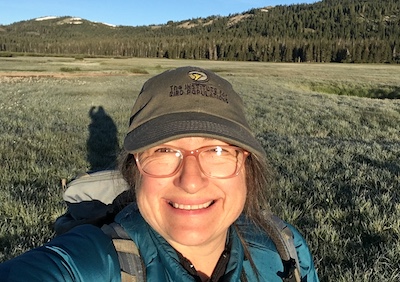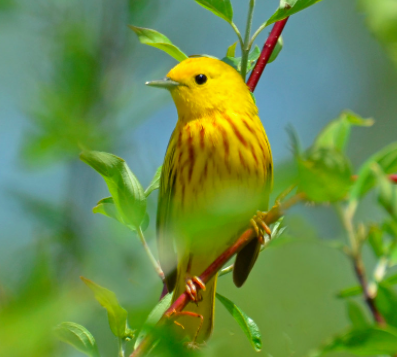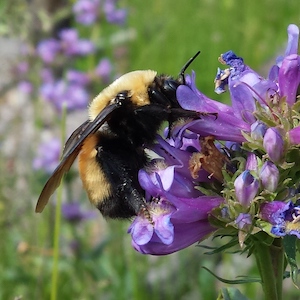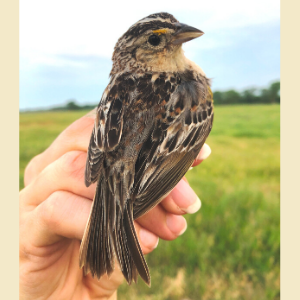Montane meadows are popular places. A disproportionate amount of birds and other wildlife species in the Sierra Nevada use these habitats, but they've also seen a disproportionate amount of human activity. This human disturbance has left many of these meadows degraded, with incised stream channels leading to drier soils and a shift in vegetation from water-loving grasses and willows, to shrubs and conifers more suited to dry conditions.
In recent years there has been a great effort to restore these meadows, motivated in large part by a desire to benefit wildlife, including threatened birds like the Willow Flycatcher. But does it work? Does meadow restoration bring the birds back? Recently IBP collaborated with scientists from Point Blue to help answer that question scientifically. The researchers did point count surveys of birds in meadows that had been restored using similar techniques, but at different time points between 1999 and 2015. Their paper was published this past month in the journal Restoration Ecology.

Sardine Valley meadow is degraded and restoration work here is planned the fall of 2020.
The simplified but good news is that, yes, meadow restoration leads to increased abundance of many bird species over time, and in some cases the birds respond surprisingly quickly. However, there was no evidence that simply restoring the hydrology of the meadows was enough to lead to their full ecological recovery or the full recovery of bird populations in the immediate post-restoration time frame. The amount of annual rainfall, position of the meadows high or low in the watershed, and especially the amount of and rate of response to restoration activities by woody riparian shrubs and trees (willows, alders, etc.) affected how quickly and strongly bird species increased in number. But the research also allowed to scientists to identify aspects of restoration that were most successful and what characteristics make a meadow a good candidate for successful restoration and bird recovery. This study validates meadow restoration efforts and will help make future restoration efforts more successful.
To learn more about meadow restoration, IBP's communications specialist Meredith Walker talked to IBP's Meadow Bird Specialist, and co-author of the new paper, biologist Helen Loffland.
Meredith: You've been working in Sierra Meadows for about 30 years, which is important because you've had time to see longer term changes. But it also suggests you really love meadows! How did you get started?
Helen: When I was a baby my family bought 80 acres including a meadow in Calaveras county, CA. As a child I loved nothing more that exploring the meadow and creek by myself and learning the plants and animals. Nothing has changed for me.

Helen in her happy place.
My first experience with meadows professionally was working on bull thistle control research in the meadows of Yosemite Valley in 1989. My first bird work in meadows was conducting Willow Flycatcher surveys for the US Forest Service starting in 1992. By 1996 I was running MAPS stations at 2 meadows on the Eldorado National Forest, spot mapping bird territories for a meadow restoration project on the Tahoe National Forest, writing grant proposals, and helping to lead a meadow restoration field day … I jumped in with both feet! I was lucky enough to share an office with a botanist and a range conservationist, so I learned a lot pretty fast just by tagging along with them.
Meredith: Compared to when you started working in these meadows, do you think there is a momentum towards positive change?
Helen: Huge momentum! Meadow restoration of the 1950s through 1980s was gully plugs and log check dams, and the jury had mostly decided those didn’t work in very many situations. It seemed like there wasn’t much appetite for trying again. But once folks really applied a more nuanced knowledge of engineering and hydrology to this process, the success stories made managers more willing to take risks. I think too, that in some places people realized that inaction was also resulting in continued downward trend for a lot of meadows.
Through the efforts of the Sierra Meadows Partnership, and groups like the Truckee River Watershed Council, plus the shot of funding from National Fish and Wildlife Foundation's Meadows Initiative around 2010, and additional funding from the State of California in the last 5 years, there have been so many more projects planned, and implemented.
The part that we are starting to learn now–and found to be true in this paper–is that while restoring hydrology is absolutely essential, sometimes that isn’t enough for meadow birds. We see that planting and protecting woody vegetation after hydrologic restoration takes place improves the pace of recovery for birds that rely on plants like willow, alder and aspen. These woody plants take longer to respond to restoration so they may need a little help to fully recover.
We are also realizing that in grazed landscapes, the creation of more, smaller pastures and use of rest/rotation grazing strategies can really help these important woody species recover.
Meredith: The research identified the "pond and plug" restoration technique, as well as other partial channel filling techniques, as the most successful. Can you explain what these are to a newbie like me?

Yellow Warbler was one of the focal species in the study. Photo by Rodney Campbell/Flickr.
Helen: Pond and plug is a technique used in meadows where the main channel has cut deep into, or incised, the soil surface and no longer allows the stream to meander near the surface and regularly flood over the meadow during spring flows. The pond and plug technique attempts to slow down the water, capture sediment to fill in the incised channel, and move water out across the meadow. This allows the meadow soils to soak up and hold onto water until later in the warm season when they will release water more slowly, which is a really important part of their hydrologic function because it reduces downstream floods in the spring and provides much needed water later into the hot season. Typically heavy equipment will dig “ponds” and use the soil and rock that is removed to create a permeable plug in the incised channel. This way when snow melts and flows downstream it fills the pond and the plug slows the water velocity further. The slowing down that is caused by the plug and pond together allow two things to happen. First sediment falls out of the water column and begins to fill the pond over time. Second, once the pond is full, the water is forced out over the meadow floodplain where it slows further from the roughness of surface vegetation and soaks into those loamy, spongy meadow soils. Pond and plug uses a series of these ponds and plugs that are carefully engineered so that only a few inches of drop occur from one to the next. The main objective is the slowing and spreading of water, so that over many years the incised channel will fill with gravel and fine sediment and the stream can find its own natural slow meander patterns that were lost when the channel was degraded.
Meredith: How do you think that climate change–which is expected to decrease the overall amount of precipitation, its form (snow vs. rain), and its variability–is going to affect these meadows?
Helen: Climate change will probably affect all meadows- both restored and unrestored, but restored meadows will have more water holding capacity, so they will be better able to deal with drying in general and the expected wide fluctuations in rain and snowpack. We may need to design our restoration projects with the understanding that they need to be able to handle more flashy rainstorms and higher high flows and lower low flows. We need to plan for unpredictability and probably less precipitation as snow. Unrestored meadows may be lost altogether, and become forest or sagebrush steppe, especially in places where snowpack in the upstream reaches is replaced by rainfall instead.

Morning at Lacey Meadow. Photo by Helen Loffland.






